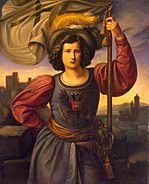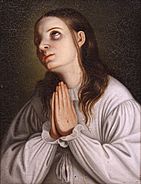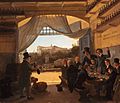Philipp Veit facts for kids
Philipp Veit (born February 13, 1793 – died December 18, 1877) was a German painter. He was known for his Romantic style and was a key member of the Nazarene movement. Veit is also famous for bringing back the old art technique of fresco painting, which means painting on wet plaster.
Contents
Early Life and Training
Philipp Veit was born in Berlin, which was then part of Prussia. His father, Simon Veit, was a banker, and his mother was Dorothea von Schlegel. After his parents divorced, Philipp lived with his mother and her new husband, Friedrich Schlegel, in different cities like Jena, Paris, and Cologne.
In 1806, he returned to Berlin to live with his father and finish school. From 1808, he started his art education at the Dresden Academy of Fine Arts. He later studied in Vienna. Philipp was very good at drawing, but he found oil painting difficult. Because of this, he focused on watercolor painting in Vienna. There, he met other Romantic artists and writers.
In 1810, Philipp and his mother became Catholic. He also fought against Napoleon in the wars of 1813–1814. During this time, he became good friends with the poet Joseph Freiherr von Eichendorff. By 1815, he had completed his first religious painting, Virgin with Christ and St John. This painting already showed his connection to the Nazarene movement, inspired by artists like Pietro Perugino and Raphael.
Time in Rome
Rome was a very important city for artists, especially those who wanted to create art inspired by faith. Artists looked to the art of the Middle Ages and early Renaissance for ideas. They often lived and worked together, much like artists in medieval workshops. This group was called the Lukasbund, or Brotherhood of St Luke.
In 1816, Veit joined this group. They lived in an old monastery called Sant'Isidoro a Capo le Case. From 1815, Veit and other artists like Johann Friedrich Overbeck and Peter von Cornelius painted frescoes in a room at the "Casa Bartholdy" (now Palazzo Zuccari). They painted scenes from the story of Joseph. Veit painted Potiphar's wife and the Seven Years of Great Abundance.
In 1817, Veit was asked to paint a fresco called The Triumph of the Religion for the Vatican. He also painted scenes from Dante Alighieri's Divine Comedy for the Casino Massimo. Around 1824, he painted Christ at the Mount of Olives for a church in Germany. In 1821, Veit married Carolina Pulini, and they had five children.
In 1824, Veit was included in a famous painting by Franz Ludwig Catel called Crown Prince Ludwig in the Spanish Wine Tavern in Rome. Veit is shown sitting at the table. From 1829 to 1830, he painted Maria Immaculata for a chapel in Rome. This was his last work from his time in Rome.
Work in Frankfurt
In October 1830, Veit moved to Frankfurt. He became the director of the art collections and a professor of painting at the Städel art institute. Some of his most famous students were Alfred Rethel and Eduard von Steinle.
Around 1832, Veit started painting scenes from ancient Greek stories, like the Shield of Achilles. He also created frescoes for the old Städel building, including The Arts Being Introduced to Germany by Christianity. This large painting showed how Christianity brought art to Germany. It also featured figures representing Germania (Germany) and Italia (Italy).
In 1848, for the first all-German Parliament held in Saint Paul's Cathedral in Frankfurt, Veit painted a second version of his Germania painting. This painting hung above the main chair and was a call for all German states to unite. Between 1840 and 1852, Veit painted portraits of four Holy Roman emperors for the "Kaisersaal" (Emperor's Hall) in Frankfurt's City Hall. These included Frederick II, Holy Roman Emperor, Henry VII, Holy Roman Emperor, Otto the Great, and Charlemagne.
From 1853 until his death in 1877, Veit was the director of the city gallery in Mainz. Like other Nazarene artists, he was often better at drawing than painting. Even though his use of color was stronger than some of his friends, his works often looked more like colored drawings than modern paintings.
Some of Veit's other important works include his Assumption in the Frankfurt Cathedral and The Two Marys at the Sepulchre, which is in the Alte Nationalgalerie in Berlin. Philipp Veit died in Mainz.
Paintings by Philipp Veit
Images for kids
-
Paradiso, Canto III: Dante and Beatrice speak to Piccarda and Constance of Sicily, detail, 1817–1827
-
Germania, 1836
See also
 In Spanish: Philipp Veit para niños
In Spanish: Philipp Veit para niños











